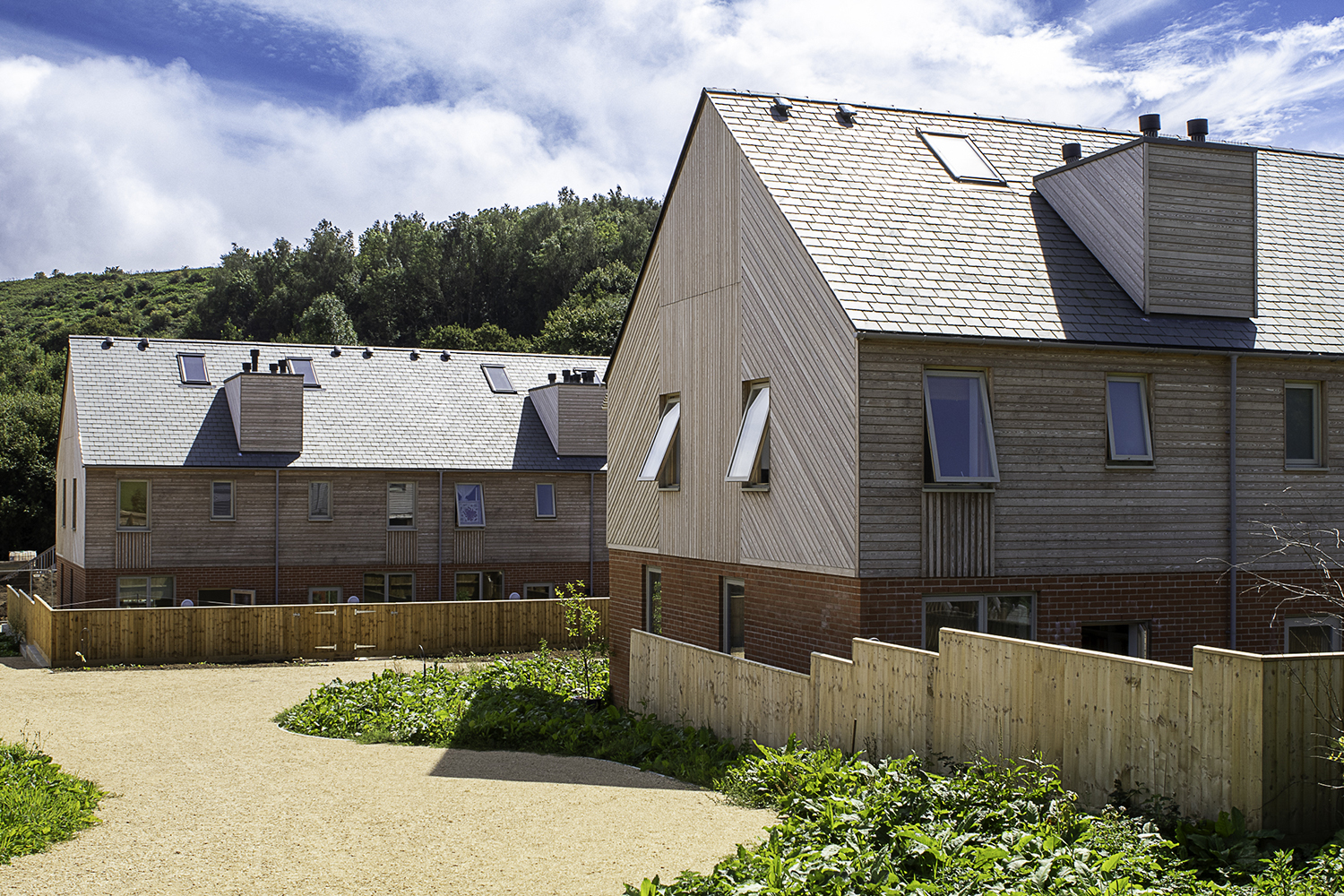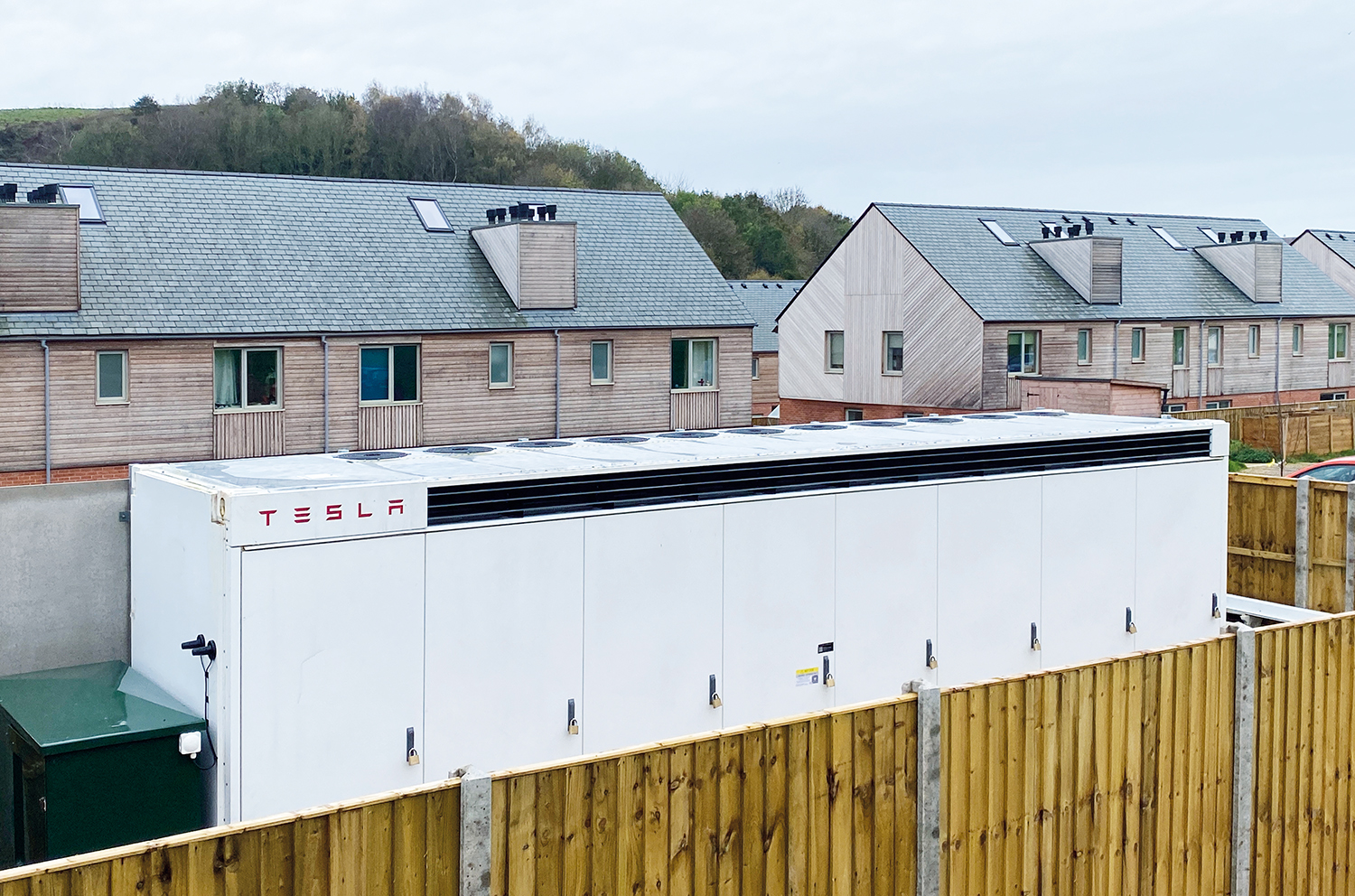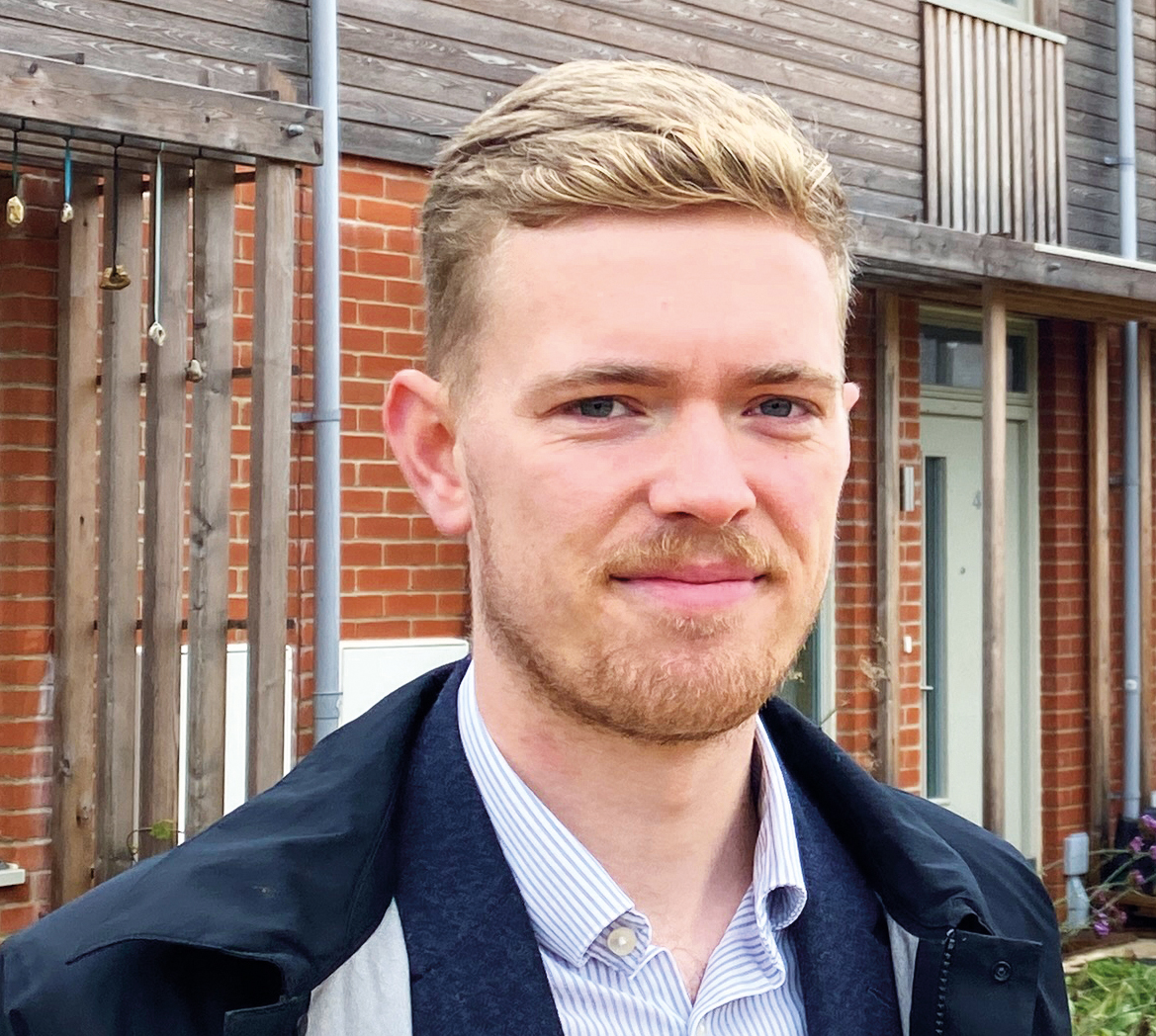
The UK’s largest cohousing development offers a new template for sustainable construction and eco living. Will Mann visited the project.
In a green hillside in deepest Dorset, a pioneering eco housing development is nearing completion. Hazelmead is the UK’s largest cohousing neighbourhood, comprising 53 affordable eco-homes for sale and for rent, through Bournemouth Churches Housing Association (BCHA).
Cohousing communities, which date from the 1960s, involve self-contained homes with communal facilities and residents who typically share similar values – in this case a strong environmental ethos.
Designed to be energy efficient, climate resilient and nature friendly, the homes on the 2.5ha-site near Bridport meet the AECB (Association for Environment Conscious Building) Standard and have near-Passivhaus levels of insulation, with U-values of 0.15 for external walls.
Hazelmead – Project overview
Client: Bridport Cohousing and Bournemouth Churches Housing Association
Main contractor: CG Fry
Architect: Barefoot Architects
Timber frame: Sevenoaks Modular
Windows: Rationel
Ventilation: Zehnder
Microgrid: Cepro
Start on site: October 2019
Practical completion: 30 November 2023
Construction value: £7.5m
Electricity comes from a microgrid serving the development, with an array of 114 rooftop photovoltaic solar panels feeding into a monster 1,609kWh-capacity Tesla battery. Some 54 air-source heat pumps power the hot water.
This is the county of Thomas Hardy, whose novels were known for their depictions of rural life, and Dorset’s most famous son would have approved of the sustainability and biodiversity themes that run right through the Hazelmead cohousing scheme.
Affordable eco homes
Work on the project first started in 2008 when a group of like-minded people formed Bridport Cohousing with the aim of building a neighbourhood of affordable eco homes for local people. The development was given full planning permission in 2016, BCHA was picked as housing association partner in 2018 and work got underway on site in October 2019.
BCHA development and acquisitions manager Jack Rushforth is giving CM a tour of the site. The housing association is managing the construction project, though main contractor CG Fry has a joint contract with BCHA and Bridport Cohousing.
“The greenfield site slopes steeply downward from north to south so it was profiled into levels through an earthworks phase,” Rushforth says. “The homes are built on strip foundations in south-facing terraces – to maximise the efficacy of the rooftop solar panels – of two-, three- and four-bed family houses, and two two-storey apartment blocks of one-bedroom flats.”

The PV panels are slim but not flush with the roofs. “We did look at inline solar PV but it would have cost about 30% to 35% more and we were conscious about the grant funding we had available and that the scheme is affordable housing.”
The microgrid and the Tesla battery will power electric heating at homes across Hazelmead. “To put the Tesla battery in perspective, it has a similar storage capacity to 30 typical electric vehicles,” Rushforth says.
Renewable power
The microgrid system allows the residents to purchase top-up renewable power from other suppliers, if needed. It connects with the mains via a transformer from next door Bridport Community Hospital.
“One of our challenges was the easement arrangements for the connection with the NHS, which also required consent from Western Power [the regional electricity distributor for National Grid], so there was quite a bit of back and forth in the design stages, and then in the implementation stages to get the various parties to agree,” says Rushforth.

“The majority of the works for the microgrid have been done by Cepro, who had experience of a previous scheme in Bristol.”
The Dimplex air-source heat pumps are contained within internal boiler cupboards, with the two-bedroom homes having slightly smaller units compared to the three- and four- bedroom houses.
“We looked at ground-source heat pumps, but air-source heat pumps proved to be easier to install and more cost-efficient for BCHA,” says Rushforth. “The actual units themselves were probably about 20% more per unit and then the groundworks costs would have been quite significant. Plus, there was more grant funding available through Homes England for using air source heat pumps at the time.”
Offsite manufacture
The homes are brick-clad at ground floor level with larch cladding above. The upper floors use structural insulated panels (SIPs) with preinstalled triple-glazed windows and insulation, manufactured off site by Sevenoaks Modular.
“It was more straightforward to fit the insulation into the SIPs because of the modular design and construction,” says Rushforth. “At ground floor, the insulation goes into the brick cavity but it was definitely a challenge, compared to traditional brick and mortar build, to get the required insulation levels in the air pressure testing results.
“For our contractor CG Fry, the biggest issue was ensuring they didn’t damage the insulation when passing services through the airtight barrier.”

Because the homes are designed as almost airtight environments, they are equipped with mechanical ventilation and heat recovery (MVHR) systems, which bring fresh air in, while recovering waste heat from stale air which is pumped out.
“We’ve given residents demonstrations on how best to utilise the air source heat pumps and MVHR system and provided a home user guide,” explains Rushforth. “There may be a tendency for people treat them like ordinary homes, opening windows in the middle of summer because they like to feel there’s fresh air coming in all the time.
“In the winter, the quality of the heat is different; you don’t have radiant heat, you have ambient heat, and there are no hot and cold spots. Which can take some getting used to if you like sitting in front of a fire.
“That said, the residents moving in generally have a high level of understanding about the green technology used here.”
Unusual features
When Hazelmead’s original planning application went in, many of the eco features the cohousing group wanted were unusual for the time.
“But the regulations and planning laws have almost caught up with what we’re doing,” says Rushforth. “The insulation levels, for example, that we looked at initially were significantly above standard levels. But these are now more in line with your traditional housebuilding standards.”
The project was delayed for three months by the Covid-19 pandemic, which struck four months after work began on site, and adverse weather. “With the topography of the site, any rainfall during the early construction stages tends to run quite quickly down the site and pool at the bottom,” explains Rushforth. “When you’re doing the trench work it does complicate things.

“We’ve given residents demonstrations on how best to utilise the eco technology and provided a home user guide.”
“Technically, having so many eco features on the project has been a big challenge, but from a professional viewpoint, you’re learning a lot about new technologies. Projects run by the larger housebuilders can be a carbon copy from one site to the other, whereas this has been a huge learning curve from the get-go.”
Contract management has also been a challenge, Rushforth says.
“With it being a joint contract with BCHA and Bridport Cohousing, we’ve had to manage the interests of both parties, plus cost restrictions and regulatory requirements and statutory obligations, and we’ve worked with the residents who are going to be living here for many years to come. There have been some tough decisions about cost versus practicality. But it’s all definitely been worth it.”
There are 13 shared ownership units and 26 for affordable rent through BCHA, with the remainder for private sale. The first residents moved into their homes in 2022 with practical completion for the whole development achieved at the end of November 2023.
Cohousing life for residents of Hazelmead

Bridport Cohousing has set an ambitious target of reducing the community’s carbon footprint by 40% over the first five years of living at Hazelmead, starting from full occupation of the site.
Contributing to this are the growing beds at the rear of houses and communal allotment patches – providing residents with access to land for cultivating food is integral to Hazelmead’s vision of food security.
The community is set in an Area of Outstanding Natural Beauty and built on former farmland, and creating a biodiverse habitat for birds, reptiles and mammals is central to the scheme, with a wildflower meadow, dormouse bridges and swift boxes on the houses.
Hazelmead will encourage use of walking, cycling and e-bikes, with car-free streets to provide safe spaces for children to play. Parking provision is in dedicated areas (with one space per household) and will include charging points for electric vehicles. An ‘e-car’ club is planned.
At the heart of the community will be the Common House, which is under construction (separate to the housing contract), and features low-carbon build methods with locally sourced materials including straw bales.
In partnership with Bridport Cohousing, the School of Natural Building (SNaB) is offering training courses as part of this community build.
Comments
Comments are closed.












Extremely interesting project. However being of a critical nature: 1. Surely by providing only one parking space per house plot is a dire on say short sighted. The car is not going away, yet anyway. The site is some what isolated from main work areas. How are members and particularly young members going to have access to work, and leisure. Was a survey do to check cars per house hold. The idea may sound good on paper but what about what really happens. 2. What is the life span for the Tesla battery and efficiency over time. What did the VE Report say about ground source v the tesla battery. I would be interested to read the VE Report in your next article on this project. However the above being said, obviously we did to move some way in this direction. We must look at the negative side of what we plan.